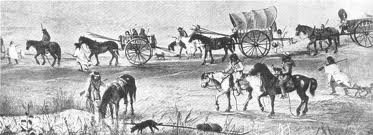Political & Economic Organizations - Additional Reading
This book will provide additional information on the historical Political & Economic Organization of First Nations and Inuit.
Traditional Government and Decision Making
Traditional Metis Governance
Before the Red River Métis began their annual buffalo hunt, they formed a government to organize the massive operation. Like other aspects of their culture, the government was a mixture of First Nations and European cultures.

Men of the camp elected a captain, usually and Elder, to lead the hunt. The captain was selected for his ability as a hunter and for qualities such as honesty and fairness. A council of lieutenants was also elected, with one lieutenant elected for every ten hunters. These officers met to determine the time, place and direction of the hunt. They were also responsible for deciding the number of animals to be killed.
Later, Métis governments reflected a similar blend of cultures. When the Métis established a provisional government at Fort Garry in 1869, it followed the principles of the buffalo hunt. All the men of the settlement over the age of twenty-one elected a council of Elders. The council, in turn, elected a president and secretary. When an issue affecting the whole community came up for debate, it was referred to the community for discussion. All elected leaders of the provisional government were expected to be accountable to the community and could be removed if the community believed they were incapable of governing.